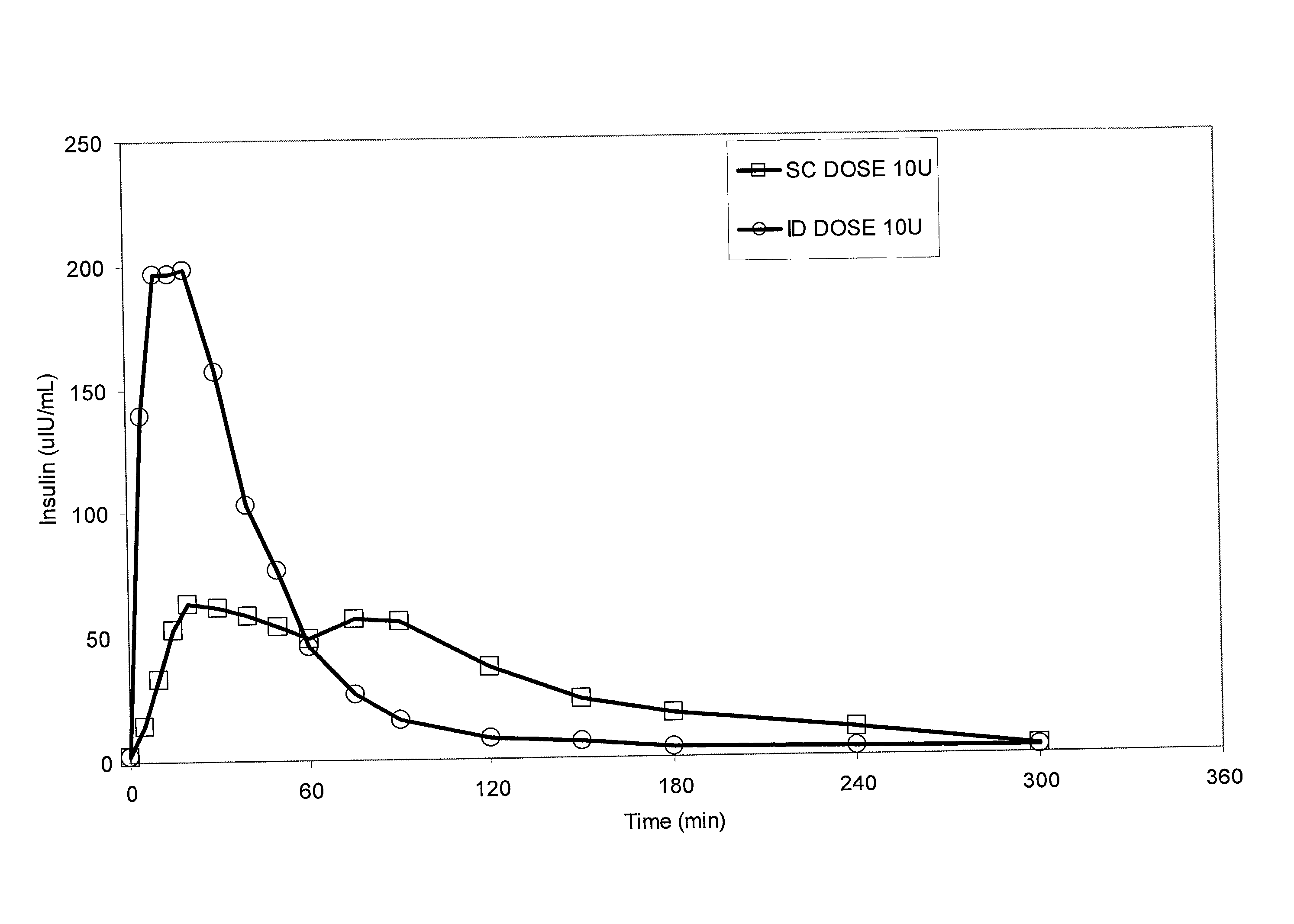Method for altering drug pharmacokinetics based on medical delivery platform
a technology of drug pharmacokinetics and medical delivery, which is applied in the direction of infusion needles, syringes, peptide/protein ingredients, etc., can solve the problems of increasing the risk of hypoglycemia, overtitudinality, and inability to accurately ascertain in real-time whether sufficient insulin has been given, so as to improve the iontophoresis rate, improve the iontophoresis, and alter the parameters of pharmacokineti
- Summary
- Abstract
- Description
- Claims
- Application Information
AI Technical Summary
Benefits of technology
Problems solved by technology
Method used
Image
Examples
example ii
[0066] Bolus delivery of Lilly Lispro fast acting insulin was performed using ID and SC bolus administration. The ID injection microdevice was dermal access array design SS3.sub.--34. 10 international insulin units (U) corresponding to 100 uL volume respectively, were administered to diabetic Yucatan Mini swine. Test animals had been previously been rendered diabetic by chemical ablation of pancreatic islet cells, and were no longer able to secrete insulin. Test animals received their insulin injection either via the microneedle array or via a standard 30 G .times.1 / 2 in. needle inserted laterally into the SC tissue space. Circulating serum insulin levels were detected using a commercial chemiluminescent assay kit (Immulite, Los Angeles, Calif.) and blood glucose values were determined using blood glucose strips. ID injections were accomplished via hand pressure using an analytical microsyringe and were administered over approximately 60 sec. By comparison, SC dosing required only 2...
example iii
[0067] Lilly Lispro is regarded as fact acting insulin, and has a slightly altered protein structure relative to native human insulin. Hoechst regular insulin, maintains the native human insulin protein structure that is chemically similar, but has slower uptake than Lispro when administered by the traditional SC route. Both insulin types were administered in bolus via the ID route to determine if any differences in uptake would be discemable by this route. 5 U of either insulin type were administered to the ID space using dermal access microdevice design SS3.sub.--34. The insulin concentration verses time data shown in FIG. 3. When administered by the ID route the PK profiles for regular and fast-acting insulin were essentially identical, and both insulin types exhibited faster uptake than Lispro given by the traditional SC route. This is evidence that the uptake mechanism for ID administration is less affected by minor biochemical changes in the administered substance, and that ID...
example iv
[0068] Bolus delivery of Lilly Lispro fast-acting insulin via microneedle arrays having needles of various lengths was conducted to demonstrate that the precise deposition of drug into the dermal space is necessary to obtain the PK advantages and distinctions relative to SC. Thus, 5 U of Lilly Lispro fast-acting insulin was administered using dermal access design SS3.sub.--34. Additional microdevices of the same needle array configuration were fabricated whereby exposed needle lengths of the microdevice array were lengthened to include arrays with needles lengths of 2 and 3 mm. The average total dermal thickness in Yucatan Mini swine ranges from 1.5-2.5 mm. Therefore insulin deposition is expected to be into the dermis, approximately at the dermal / SC interface, and below the dermis and within the SC for 1 mm, 2 mm, and 3 mm length needles respectively. Bolus insulin administration was as described in EXAMPLE II. Average insulin concentrations verses time are shown in FIG. 4. The dat...
PUM
| Property | Measurement | Unit |
|---|---|---|
| Mass | aaaaa | aaaaa |
| Length | aaaaa | aaaaa |
| Length | aaaaa | aaaaa |
Abstract
Description
Claims
Application Information
 Login to View More
Login to View More - R&D
- Intellectual Property
- Life Sciences
- Materials
- Tech Scout
- Unparalleled Data Quality
- Higher Quality Content
- 60% Fewer Hallucinations
Browse by: Latest US Patents, China's latest patents, Technical Efficacy Thesaurus, Application Domain, Technology Topic, Popular Technical Reports.
© 2025 PatSnap. All rights reserved.Legal|Privacy policy|Modern Slavery Act Transparency Statement|Sitemap|About US| Contact US: help@patsnap.com



